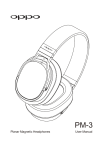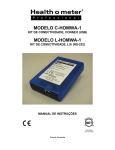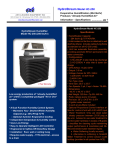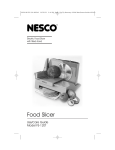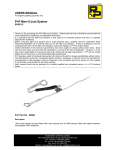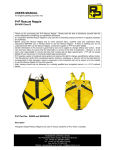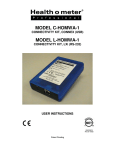Download P+P HORIZONTAL LIFELINE USERS OPERATING INSTRUCTIONS
Transcript
v1 11/05 P+P HORIZONTAL LIFELINE USERS OPERATING INSTRUCTIONS EN795:1997 Class C Supplied by Pammenter & Petrie Limited PAMMENTER & PETRIE LIMITED 140-146 Brearley Street. Hockley, Birmingham B19 3XJ Tel: +44 (0) 121 359 4561 (Sales) Tel: +44 (0) 121 503 5860 (Training) Fax: +44 (0) 121 359 4136 Website: www.pammenter.co.uk E-mail: [email protected] USE OF THE LINE WITH 2 PERSONS P+P HORIZONTAL LIFELINE (HLL) The HLL has also been tested and approved two-person use - for fall arrest. This was achieved by loading the centre of the line with 26kN (2650kg). To ensure the safety of two users on the HLL, the minimum clearance values given below must be adhered to at all times. The HORIZONTAL LIFELINE has been CE marked by P+P Ltd to 89/686/EEC using the procedures described in BSEN 795:1997 for class C devices. Certified by Approved Body: SATRA, Safety Product Centre, SATRA House, Rockingham Road, Kettering, Northants, NN16 9JH, UK. Identification No: 0321. HLL position above user’s foot level MINIMUM clearance required below user’s feet. Ensure that anchor points are adequate, at least 30kN. P+P recommends that all PPE equipment is personal issue, all documentation relating to it, is kept on file until the item is withdrawn from service. 2.0m 1.25m 0.0m 8.0m 8.75m 10.4m An EN 795:1997 class C device is described as an anchor line. It has been subjected to dynamic tests using a non shock absorbing lanyard and a 100kg mass in a 4m fall. The P+P line has also been tested with a static load of 36kN without failure. 2 P+P Anchorage Sling IMPORTANT: It is vital that anchor points are sufficiently strong, they should be capable of withstanding a minimum of 15kN horizontally and in the direction of the line. The high anchor rating is due to the vector forces generated in the high angle ‘Y’ formed in the line when loaded. Karabiner Fig. A NOTE: When used as an anchor for a restraint system – as opposed to fall arrest – then more than one operative can use the line at one time. You must be certain that all operatives are in restraint at all times, with no potential fall. 35mm Webbing FITTING INSTRUCTIONS Fig. B 1. When the assembly is at the required location, remove the short fixed (50mm webbing) part and make the necessary connection to the anchor point (Fig. A). 2. Unpack the adjustable (35mm webbing) part and attach to the other anchor point. Take care not to have twists in the line (Fig. B). Ratchet 3. When both connections have been made the next step is to take up the ‘coarse’ adjustment, to do this the ratchet should be in the position shown (Fig. C). Fig. C 3 When this stage is reached, tensioning can now begin. This is done by ‘plumping’ the ratchet handle as shown (Fig. D). NOTE: On pre-2004 models there is no indication of how much tension is in the system. P+P recommend that only one hand is necessary without over exerting. Using both hands and over exerting, or using a lever is not necessary and at a height can be dangerous. 2004 models feature a Tension Force Indicator on the fixed bar of the ratchet. Tension as above, until it has closed beyond the 250dN mark. Indicator Spreader Bar Fig. D 4. Ensure that at least 1½ complete revolutions of the spreader bar have taken place (Fig. D). At the same time do not overload the spreader bars with webbing, if this happens, the webbing will jam. Should this happen it will be necessary to release the webbing and start the tensioning operation again (see releasing operation). 5. When tensioning is complete, position the ratchet in the locked position (Fig. E). 6. Finally pack away surplus webbing into the bag and buckle up. Fig. E Releasing the Tension and Removal 7. Releasing the ratchet handle will allow you to open up the ratchet. Allowing the ratchet to re-grip the ratchet ring under slight tension, pull the ‘tab’ back from the ratchet ring. Pulling back on the ratchet release handle and tab at the same time, you can then pull the webbing off the spreader bar as shown in Fig. F. 8. Remove from anchorage and pack away into bag. Ratchet Ring Release Tab Ratchet Release NOTE: A neatly packed bag will aid easy deployment when next used. 4 Fig. F FITTING INSTRUCTIONS FOR USE WITH ANCHORAGE SLING (90287 / 90302) Prior to fitting the line as described previously, it is necessary to fit the two other anchorage slings (Fig. G). These should be positioned as high as possible above the user, thus ensuring that in the event of a fall the distance is kept to a minimum. (Fig. H & Fig. I). P+P Anchorage Sling Fig. G By fitting the anchorage sling in the correct configuration, it will ensure that the Horizontal Lifeline will remain in the position it is fitted. This will aid assembly of the overall system. Important Points 1. Thoroughly inspect all components before and after fitting. 2. Do not use additional bars or levers to induce a higher tension in the line. This will increase end anchor loads in the event of a fall. 3. Ensure that harness/lanyard attachments, karabiners etc. are free from sharp edges or burrs. Fig. H 4. Ensure that anchor points are adequate, at lease 15kN. (30kN for 2 persons). 5. Ensure that when using attachment straps the sleeve is suitably positioned to prevent any abrasion or cutting of the straps. Fig. I NOTE: Clearance Required Below User Due to the fact that the line deflects when loaded, users and installers must consider the clearance required below the Horizontal Lifeline to ensure the users’ safety in the event of a fall. The danger to the user can be greatly reduced if the line is installed at head height, and/or shorter lanyards are used to connect. These factors combine to reduce the graph on the next page, which explains the safe clearance X when used with P+P Chunkie or NRG Fall Arrest Lanyards (Fig. H, I, J and K). 5 HAZARD CLEARANCE GUIDE Fig. J EXAMPLE A 15m line is set up at 1.25m above foot level, and a 2m P+P Chunkie or NRG Fall Arrest Lanyard is used to connect the user. The necessary clearance required is 5.2m below the user’s feet. If you require more detailed installation information, please contact P+P. Fig. K IMPORTANT: Please note that the test results were achieved using P+P Chunkie Fall Arrest Lanyards, and a 100kg (16st) mass, therefore, clearances for persons over 100kg should be increased. Only P+P Chunkie or NRG Lanyards are compatible with these clearance figures. These figures cannot be used with other manufacturers’ fall arrest lanyards. Two persons – For installation guidance see Page 2. 6 WARNINGS: INSPECTION AND EXAMINATION 1. Be aware of any additional fall hazards at the anchor ends of the line. Keep these instructions, or a copy with the Horizontal Lifeline to aid future inspection and examination. Examination by a competent person at intervals of 6 months is mandatory under The Work at Height Regulations 2005. The Horizontal Lifeline should also be examined before every use by the user/installer, particular attention being paid to the following:- 2. If working in restraint your system should be set up to prevent a fall from occurring. 3. Be aware of all medical conditions that could affect the safety of the user in normal and emergency use. 4. This equipment should only be used by persons trained and competent in its safe use. 5. A rescue plan should be in place to deal with any emergencies that may arise during work. 6. No alterations, additions or repairs should be made to this equipment without the written consent of P+P. 7. The equipment should not be used outside the limitations, or for any other purpose that it is intended for. 8. The safe function of one item of equipment may interfere with the safe function of another with certain combinations of equipment. 9. In any fall-arrest system, the free space required below the user should always be ensured. 10. If in any doubt about the use or care of P+P equipment, please contact P+P. Black Thread Webbing – check for cuts, cracks, tears, abrasion and scorch marks, burns or chemical attack Stitching – Look for broken stitch, loose or worn threads. Metalware – Inspect for signs of damage or distortion and that all moving parts and springs are fully operational. The HLL should be removed from service and inspected after being subjected to any fall. Local abrasion as distinct from general wear may be caused by the passage of the webbing over sharp edges or protrusions while under the tension and may cause serious loss of strength. Slight damage to outer fibres and occasional yarn may be considered harmless but serious reduction in width or thickness of the webbing or serious distortion to the weave pattern should lead to rejection. NOTE: As a guide to establish how much wear is acceptable, a distinct black thread of a different construction, is woven into the selvedge of the black webbing. (Fig. L). When this becomes clearly visible, it should be inspected and refurbished by P+P, for further details of the level of service in your area contact your supplier. PAMMENTER & PETRIE LIMITED 140-146 Brearley Street. Hockley, Birmingham B19 3XJ Tel: +44 (0) 121 359 4561 (Sales) Tel: +44 (0) 121 503 5860 (Training) Fax: +44 (0) 121 359 4136 Website: www.pammenter.co.uk E-mail: [email protected]







